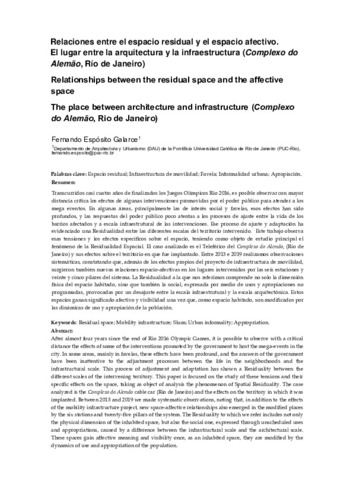Mostra el registre d'ítem simple
Relaciones entre el espacio residual y el espacio afectivo: el lugar entre la arquitectura y la infraestructura (Complexo do Alemão, Río de Janeiro)
| dc.contributor.author | Espósito Galarce, Fernando |
| dc.coverage.spatial | east=-43.2709422; north=-22.8581795; name=Av. Central, 710 - Complexo do Alemão, Rio de Janeiro - RJ, 21061-700, Brasil |
| dc.date.accessioned | 2020-09-21T17:37:26Z |
| dc.date.available | 2020-09-27T00:26:50Z |
| dc.date.issued | 2020-09-28 |
| dc.identifier.citation | Espósito Galarce, F. Relaciones entre el espacio residual y el espacio afectivo: el lugar entre la arquitectura y la infraestructura (Complexo do Alemão, Río de Janeiro). A: Llop, C.; Cervera, M.; Peremiquel, F. (eds.). "IV Congreso ISUF-H: Metrópolis en recomposición: prospectivas proyectuales en el Siglo XXI: Forma urbis y territorios metropolitanos, Barcelona, 28-30 Septiembre 2020". Barcelona: DUOT, UPC, 2020, p. 1-21. ISBN 978-84-9880-841-4. |
| dc.identifier.isbn | 978-84-9880-841-4 |
| dc.identifier.uri | http://hdl.handle.net/2117/329040 |
| dc.description.abstract | Transcurridos casi cuatro años de finalizados los Juegos Olímpicos Rio 2016, es posible observar con mayor distancia crítica los efectos de algunas intervenciones promovidas por el poder público para atender a los mega eventos. En algunas áreas, principalmente las de interés social y favelas, esos efectos han sido profundos, y las respuestas del poder público poco atentas a los procesos de ajuste entre la vida de los barrios afectados y a escala infraestrutural de las intervenciones. Ese proceso de ajuste y adaptación ha evidenciado una Residualidad entre las diferentes escalas del territorio intervenido. Este trabajo observa esas tensiones y los efectos específicos sobre el espacio, teniendo como objeto de estudio principal el fenómeno de la Residualidad Espacial. El caso analizado es el Teleférico del Complexo do Alemão, (Rio de Janeiro) y sus efectos sobre el territorio en que fue implantado. Entre 2013 e 2019 realizamos observaciones sistemáticas, constatando que, además de los efectos propios del proyecto de infraestructura de movilidad, surgieron también nuevas relaciones espacio-afectivas en los lugares intervenidos por las seis estaciones y veinte y cinco pilares del sistema. La Residualidad a la que nos referimos comprende no solo la dimensión física del espacio habitado, sino que también la social, expresada por medio de usos y apropiaciones no programadas, provocadas por un desajuste entre la escala infraestrutural y la escala arquitectónica. Estos espacios ganan significado afectivo y visibilidad una vez que, como espacio habitado, son modificados por las dinámicas de uso y apropiación de la población. |
| dc.description.abstract | After almost four years since the end of Rio 2016 Olympic Games, it is possible to observe with a critical distance the effects of some of the interventions promoted by the government to host the mega-events in the city. In some areas, mainly in favelas, these effects have been profound, and the answers of the government have been inattentive to the adjustment processes between the life in the neighborhoods and the infrastructural scale. This process of adjustment and adaptation has shown a Residuality between the different scales of the intervening territory. This paper is focused on the study of these tensions and their specific effects on the space, taking as object of analysis the phenomenon of Spatial Residuality. The case analyzed is the Complexo do Alemão cable car (Rio de Janeiro) and the effects on the territory in which it was implanted. Between 2013 and 2019 we made systematic observations, noting that, in addition to the effects of the mobility infrastructure project, new space-affective relationships also emerged in the modified places by the six stations and twenty-five pillars of the system. The Residuality to which we refer includes not only the physical dimension of the inhabited space, but also the social one, expressed through unscheduled uses and appropriations, caused by a difference between the infrastructural scale and the architectural scale. These spaces gain affective meaning and visibility once, as an inhabited space, they are modified by the dynamics of use and appropriation of the population. |
| dc.format.extent | 21 p. |
| dc.language.iso | spa |
| dc.publisher | DUOT, UPC |
| dc.rights | Attribution-NonCommercial-NoDerivs 3.0 Spain |
| dc.rights.uri | http://creativecommons.org/licenses/by-nc-nd/3.0/es/ |
| dc.subject | Àrees temàtiques de la UPC::Urbanisme |
| dc.subject | Àrees temàtiques de la UPC::Enginyeria civil |
| dc.subject.lcsh | Slums -- Brasil -- Rio de Janeiro |
| dc.subject.lcsh | Aerial tramways -- Brazil -- Rio de Janeiro |
| dc.subject.other | Espacio residual |
| dc.subject.other | Infraestructura de movilidad |
| dc.subject.other | Favela |
| dc.subject.other | Informalidad urbana |
| dc.subject.other | Apropiación |
| dc.subject.other | Residual space |
| dc.subject.other | Mobility infrastructures |
| dc.subject.other | Slum |
| dc.subject.other | Urban informality |
| dc.subject.other | Appropriation |
| dc.title | Relaciones entre el espacio residual y el espacio afectivo: el lugar entre la arquitectura y la infraestructura (Complexo do Alemão, Río de Janeiro) |
| dc.title.alternative | Relationships between the residual space and the affective space: the place between architecture and infrastructure (Complexo do Alemão, Rio de Janeiro) |
| dc.type | Conference report |
| dc.subject.lemac | Barraquisme -- Brasil -- Rio de Janeiro |
| dc.subject.lemac | Telefèrics -- Brasil -- Rio de Janeiro |
| dc.rights.access | Open Access |
| local.citation.contributor | Llop, C.; Cervera, M.; Peremiquel, F. (eds.) |
| local.citation.pubplace | Barcelona |
| local.citation.publicationName | IV Congreso ISUF-H: Metrópolis en recomposición: prospectivas proyectuales en el Siglo XXI: Forma urbis y territorios metropolitanos, Barcelona, 28-30 Septiembre 2020 |
| local.citation.startingPage | 1 |
| local.citation.endingPage | 21 |


